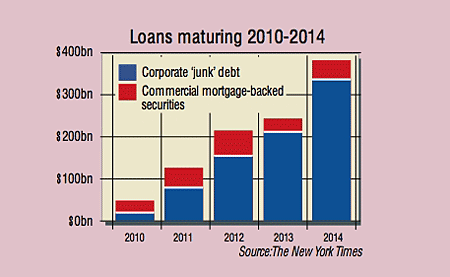
The junk-bond bulls are out in force, says John Glover on Bloomberg.com. Globally, high-yield debt is on track to produce the highest monthly average return since last September, according to Bank of America Merrill Lynch.As money pours in, US high-yield spreads are at lows for the year. Investors are pouring cash into junk-bond funds at the fastest pace on record as default rates decrease, say EPFR Global. Meanwhile, issuance of junk bonds is running at its fastest monthly pace since mid-2007, with the bulk of sales in the US. But watch out – trouble lies ahead.
In 2012, “an extraordinary surge” of risky, high-yield US debt will become due, says Nelson D Schwartz in The New York Times. No less than $700bn of dodgy debt will mature over those three years: $155bn in 2012, $212bn the year after, and $338bn in 2014. That compares to just $21bn this year. The post-2012 surge is due to the fact that many of the loans were made to finance leveraged buyouts, and they typically come due in five to seven years. The “long-delayed reckoning” for loose lending up to 2007 is on its way. Texan utility TXU, for example, taken over by KKR, will need to refinance $21bn in 2012-2014.
So, an avalanche is on the way in 2012 and beyond, says Kevin Cassidy of Moody’s. A massive “maturity wall” could overload the market, setting off a series of defaults and bankruptcies as the scramble for debt raises interest rates. That in turn could threaten the economy by reducing employment and consumption, says Schwartz. It hardly helps that junk borrowers have to compete with the government – it will have to borrow $2trn in 2012 alone – as well as investment-grade corporates ($1.2trn in 2012-2014) and commercial mortgage-backed securities rollovers. The government’s borrowing means that “other players will get crowded out or have to pay significantly more”, says Tom Atteberry of First Pacific Advisors.
Moreover, this debt mountain looms “in an environment of what is likely to be below-trend economic growth” as the stimulus wears off, says Michael E Lewitt of Harch Capital Management. The benchmark Fed interest rate, meanwhile, has nowhere to go but up, which hardly bodes well for bonds. All in all, the outlook for corporate credit “is extremely troublesome”.